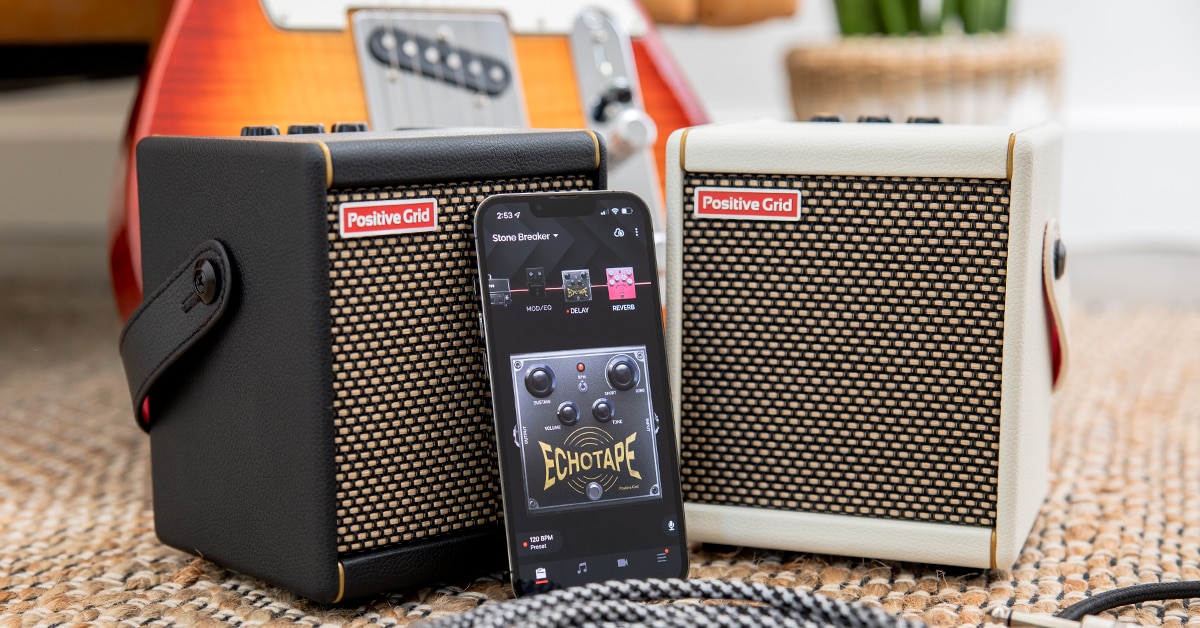As technology continues to evolve at blistering speeds, the old duck test—“If it looks like a duck, swims like a duck and quacks like a duck, then it probably is a duck”—seems more and more like fodder for the recycling bin. Consider the Positive Grid Spark MINI. It looks like a mini amp. It roars like a guitar amp. You plug a guitar or bass into it. But, um, you can’t really call it “just” a tiny guitar amp.
This pint-sized powerhouse is perhaps more accurately an interactive, multitasking tool for tone creation, jamming, learning, and having big fun. It’s a musical fantasy camp in a teensy package.
If that sounds a bit much, here are the details. The Spark MINI offers four onboard sounds, but when you add the Spark app to the mix, you suddenly increase the bounty of tone to 33 amps and 43 effects. Still not impressed? You can access more than 10,000 sounds when you log into Positive Grid’s ToneCloud community. But we’re just getting started. If you want to jam with some backing tracks, Spark MINI doesn’t just provide a canned rhythm section that never changes. Instead, Spark MINI’s AI-driven backing tracks automatically react to your playing—just like a great band of human musicians—and lays down the right grooves in real time. You don’t even have to take the time to select an amp sound in order to start jamming. The Spark MINI recommendation engine learns your sonic desires and serves up tones that match your usual selection for the style of music you’re playing. If you want to improve your chops, the Spark app is always at the ready to offer tons of automatic learning tools, tutorials and other educational resources. Bluetooth is onboard for streaming tracks to play along with and jam, and the amp does double duty as a Bluetooth audio speaker when you just want to relax and listen to some music. Spark MINI may be petite enough to fit into the palm of your hand, but it delivers a gigantic medley of tone crafting, education and entertainment.
Positive Grid Vice President of Product Design Ethan Lu kicked off his career in the consumer electronics market, and the unbridled, benevolently disruptive tech-industry approach he and his team took toward music gear helped drive the expansive features, look and feel of Spark MINI. In this exclusive interview, Lu talks about not designing Spark MINI for a particular user, envisioning a guitar amp as a monitor speaker and his personal-favorite feature on the tiny tone machine.
The HUB: When you started designing Spark MINI, did you have a specific vision of the customer who might be using the amp?
Ethan Lu: Not necessarily. We avoided that type of thinking. When I was in school studying product design, a professor asked the class, “What is the best product in the world?” Then, he answered it was Coca-Cola, because Coke didn’t define the user. You see Coca-Cola everywhere—fancy places and ordinary places—and you don’t have to be a special person to buy it.
Of course, there are some consumer products that are very much related to who you are as a person. In fact, when I first joined the electronics industry as a product designer, we were focused on personas—student laptops, business laptops, and so on. But guess what happened? The Apple MacBook came out. And that, I think, became the second-best product in the world after Coca-Cola, because you saw everyone from art students to people from Wall Street using the same laptop. No one was judging whether or not they were the “right person” for a MacBook. It was everywhere.
Now, it’s hard to make something universal like that. There’s no design “process” for it. You have to dig into the core concept, and for Spark MINI, that was getting people to play more and focus on making music.When I look at the Spark guitar amp and Spark MINI, I don’t see a premium amp or a practice amp. I just see smart tech that everyone can enjoy. There’s no need to separate 14-year-old players from 40-year-old players, or whether the amps are being used around a campfire or played while sitting on a couch. It’s more about enjoying the act of playing, whether you’re a beginning guitarist or bassist, or an advanced one. Because of that, we made sure that “personas” did not impact the design of Spark MINI.
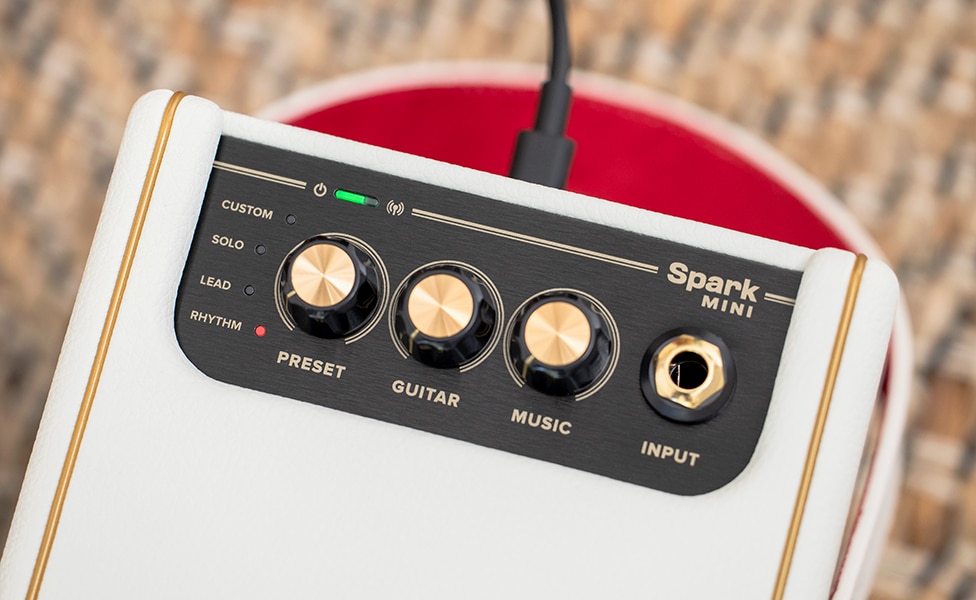
The HUB: Spark MINI is built on the Positive Grid BIAS engine, which is a popular amp and effects-modeling platform. What are the main differences between the big software offering and the version included in the amp?
EL: The fundamental technology is very similar, but BIAS FX 2 Elite has more than 210 factory presets and the selections are expandable through the Positive Grid ToneCloud. The amp and effects collection in Spark MINI is smaller, but it still provides you with a broad range of sounds. You can be a metal maniac one day and transform yourself into a night-club jazz player the next. We’ve got you covered now, and we are constantly working on new tones and features.
The HUB: It’s interesting that you didn’t conceive of Spark MINI as simply a miniaturized version of the Spark guitar amp.
EL: We had two primary concepts for Spark: a guitar amp and a music speaker. The Spark amp is a guitar amp that plays music, and Spark MINI is kind of the reverse. It’s a neutral studio monitor designed to reproduce music, as well as being able to handle the sounds of different instruments such as electric guitar, acoustic guitar and bass. So, when we designed the Spark guitar amp, we referenced conventional amp structure—the woods used to make cabinets, the acoustic properties, and so forth. In essence, we made a guitar amp, just smaller, and with many innovative features. For Spark MINI, we were not trying to make a smaller version of the Spark amp. We wanted to make an extremely neutral-sounding speaker that would make our BIAS-based Spark DSP shine, and transform Spark MINI into any amp you like.
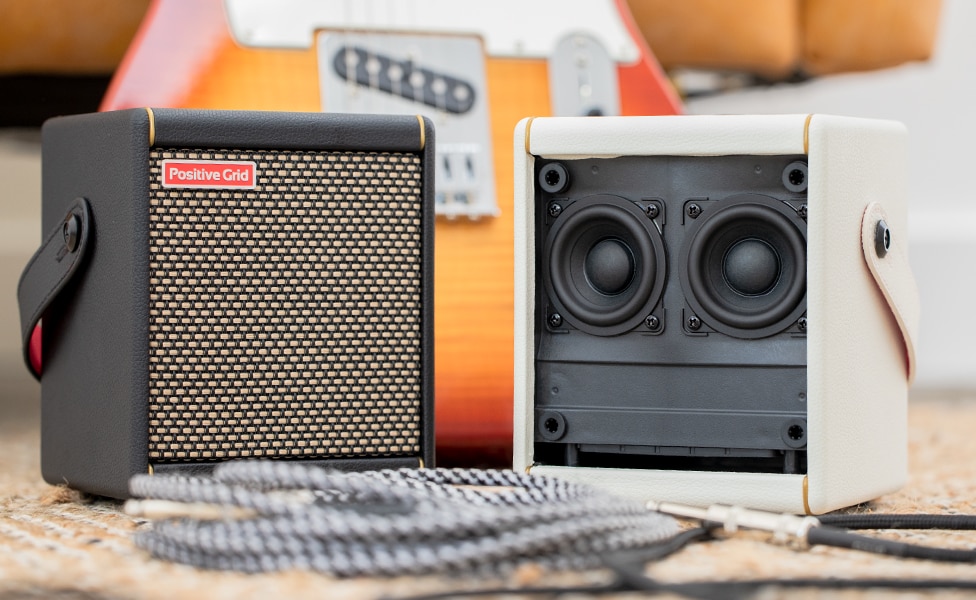
The HUB: Was one design strategy more exciting to you personally than the other?
EL: I love both projects, but I’m an audiophile, so I really enjoyed designing Spark MINI. We committed to delivering high-end audio, and we put a lot of energy into the details to provide high-fidelity tone. For example, we tested several versions of the cabinet using different thicknesses and acoustic formulas to see how they influenced the tone. We even looked at the design of the feet, which contact surfaces at just three points. This configuration helps isolate the Spark MINI from whatever it is sitting on, and therefore produces taut and focused bass frequencies. It’s a tiny little detail you might find in a high-end music speaker, rather than a guitar amp, but it makes a significant difference to the sound quality.
Then, we angled the two speakers slightly in different directions to expand the sound stage and widen the stereo image. In fact, during the design stage, we debated whether to make Spark MINI a mono or stereo amp. Most tiny amps stick with mono, but we pushed for a very nice stereo image. Again—little details.
The HUB: The Spark app is really designed for education and entertainment. It serves up increased options for dialing in tones, but it also offers some how-to-play guidance, as well as interactive play-along features and more. How the app encourages you to play is truly wonderful.
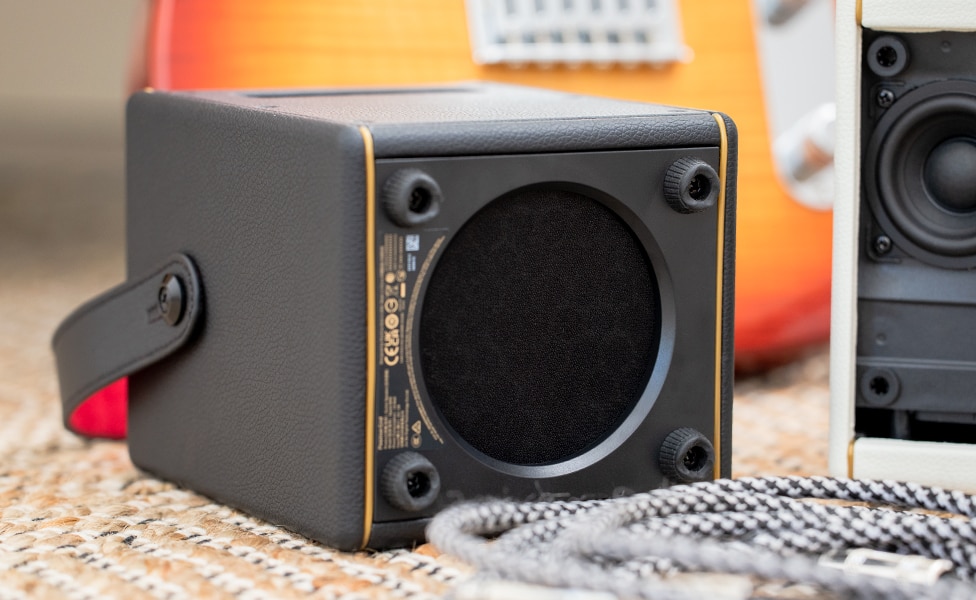
EL: Well, that element was essential, as our core philosophy is to encourage people to play more. We also want you to enjoy playing, so every aspect of the app is designed to support that—such as Smart Jam, which is a clear favorite for many Spark owners. And, remember, this isn’t just an electric-guitar amp. If you’re into acoustic guitar and/or bass, the app includes amps and tones just for you, and we’re working to expand the library even more.
The HUB: When you’re out jamming, how long can you expect the battery power to last?
EL: A little more than 8 hours—although if you play at full volume, the battery life will drop to around 5 or 6 hours.
The HUB: For home-recording musicians, Spark MINI can also be used as a USB audio interface.
EL: That’s right. Spark MINI operates as a 1 in, 2 out USB interface at a sample rate of 44.1kHz and a bit depth of 16. Simply put, any sounds you create using the Spark MINI or Spark app can be seamlessly recorded using the included PreSonus Studio One Prime software, or whichever DAW you choose.
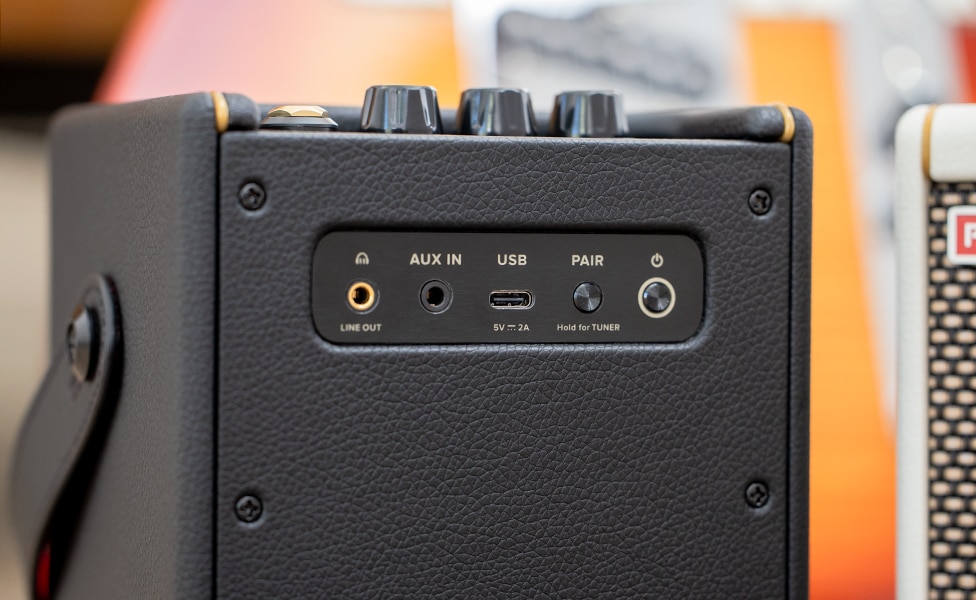
The HUB: How do you use the Spark MINI, and what is your favorite feature?
EL: About 99 percent of the time, I’m playing along with a backing track when I’m using Spark MINI. So, my favorite feature is the recommendation engine that curates a tone to match whichever backing track I’m playing. I’m not looking for a signature tone I can use every time I play—I like to be surprised.





































































































































